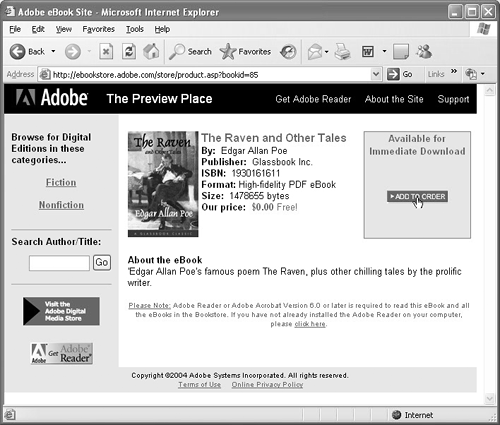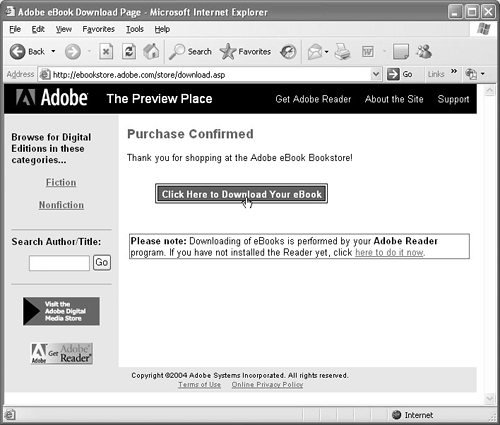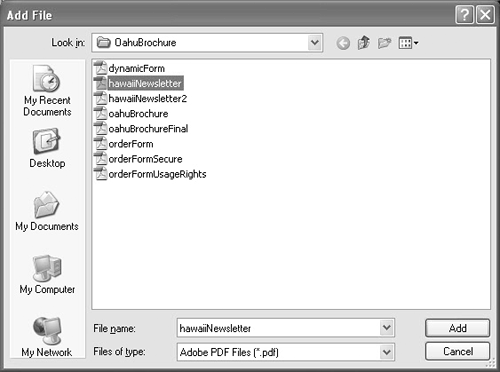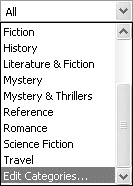Adobe Digital Editions are PDF files that have been specially packaged to protect the copyright of the author and publisher, and are typically distributed by content providers as eBooks and other types of electronic documents. Digital Editions can be eBooks, eMagazines, ePeriodicals, or any other kind of electronic document that a content provider wants to distribute. The common denominator, of course, is a PDF file.
Digital Editions services offer users opportunities to purchase electronic content, join subscription services, and participate in borrowing programs much like borrowing books from a library.
In addition, some Adobe Reader features associated with Digital Editions can also be used for organizing PDF documents on your hard drive. Any kind of PDF file can be listed in a window, categorized, subcategorized, and accessed easily. To learn how to organize your files, you should first become familiar with Digital Editions.
Before you can purchase or read a Digital Edition you must first activate Adobe Reader. Activation is a one-time process that automatically prepares Adobe Reader to view and share Digital Editions on multiple computers or mobile devices. Through the activation process—in Adobe parlance it's called activating an account—you are taken to Adobe's Web site, where you create either an Adobe ID or a Microsoft .NET ID that is used whenever you download Digital Editions from Adobe's Web site or other content providers.
When you download your first protected Digital Edition, Adobe Reader initiates an Easy Activation process. Once Adobe Reader is activated, you can download additional Digital Editions without reactivating the Reader program on your computer.
To complete the Easy Activation for the first time:
Be certain you have an Internet connection active. Select File > Digital Editions > Adobe Digital Media Store.
Tip
If you don't have the full version of Adobe Reader installed on your computer, you can complete the activation by visiting the Adobe Digital Media Store at http://adobedigitalmediastore.overdrive.com.
The Adobe Digital Media Store Web page opens in your default Web browser. Click a link to a free Digital Edition download. Note that the Web page may change periodically. As of this writing, you can access free Digital Edition downloads by clicking the Try an eBook link (Figure 20.1).
A second Web page opens, where you can select several free Digital Editions. Select an edition listed under the title: Free Preview Content From Leading Publishers (Figure 20.2). Note again that the Web page changes periodically. If you don't see the same Web page design, poke around the Adobe Digital Media Store to find a free download link.
Follow the onscreen instructions to download the Digital Edition. The Easy Activation process begins. The last Web page in the Easy Activation process is a congratulatory page confirming your activation. If you quit the activation sequence at this point, you can begin reading the downloaded eBook in Adobe Reader.
Full activation permits you to move and copy editions to other computers or handheld devices. The Full Activation activates Adobe Reader using an Adobe ID or a Microsoft .NET Passport ID. Either ID you use to activate Adobe Reader permits you to move and copy editions you download free or purchase from content providers. You'll see an option on the congratulatory Web page to complete a full activation.
To complete the Full Activation:
If you elect to complete the Full Activation when you arrive at the congratulatory Web page during Easy Activation, click the Sign In And Reactivate button. If you haven't completed the Full Activation, select File > Digital Editions > Authorize Devices.
The Adobe DRM (Digital Rights Management) Activator Web page opens. If you have a Microsoft .NET Passport ID, click the Sign In button (Figure 20.3). If you need to set up an ID, click the Sign up for a .NET Passport link. If you prefer to use an Adobe ID, click the link below the table where you see I prefer not to sign in using Microsoft.NET Passport. Clicking this button opens a Web page where you can create an Adobe ID. Note that the preferred ID for use with Digital Editions is the .NET Passport ID.

Figure 20.3. Click a link to create an Adobe ID or a Microsoft .NET Passport ID. Using Microsoft .NET Passport is the preferred choice.
Tip
If you use MSN Hotmail or MSN.account, you already have a .NET Passport ID. Sign in using your existing email address and password. If you forgot your password or don't have an account, click the link on the Adobe DRM Activator Web page where you see Reset my .NET Passport password. You are prompted to create a new password. Follow the instructions on the Web pages that follow to create a new log-in password.
If you have ever shopped using Adobe Online Services or purchased items at the Adobe Store, you already have an Adobe ID.
Follow the instructions on the subsequent Web pages to complete your activation. Be certain to make note of the password you use when you create your ID. After completing the activation, you can copy Digital Editions to a maximum of six different computers and/or mobile devices.
After you activate Adobe Reader and set up an account, you can download as many Digital Editions as you desire. You can find free eBooks available on Adobe's Web site, as well as many subscription services on the Internet for downloading magazines and periodicals. Other content providers such as eBooks.com, fictionwise.com, and efollet.com offer libraries of fiction and nonfiction works you can purchase online.
To acquire a free Digital Edition from Adobe's eBook site:
Select File > Digital Editions > Adobe Digital Media Store. Alternately, you can use your Web browser and log on to http://adobedigitalmediastore.overdrive.com. Click on the Try an eBook link. The Try Adobe Digital Editions Web page opens.
Click on a link listed below Free Preview Content From Leading Publishers. Several eBooks are listed. In this example I use the link to The Raven and Other Tales by Edgar Allen Poe. A Web page opens describing the book and a link to add the book to an order.
Click the Add to Order link (Figure 20.4) to proceed to the next Web page.
A second Web page opens, with a link to commence the download. Click the Click Here to Download Your eBook link (Figure 20.5).
A dialog opens as the download is in progress. After the download is complete, the eBook opens in Adobe Reader (Figure 20.6). Notice that the comment tools are visible in the Toolbar Well. You can use the tools to comment on pages in your eBook. Using any of the comment tools, add some comments to the pages in the document.
Close the file by pressing Ctrl/Command+W, or click the close box (top-right corner on Windows or top-left corner on Macintosh).
Reopen the file by selecting the file in your most recently viewed file list. In Windows the recently viewed list appears at the bottom of the File menu. On the Macintosh the filename appears when you select File > Open Recent File. Notice that the comment notes you made on the document are still present.
Digital Editions are conveniently stored in a location called My Digital Editions. The My Digital Editions window is where you can add new editions from any PDF file, categorize editions, email copies of eBooks to friends and colleagues, and perform maintenance functions.
To access the My Digital Editions window, select File > Digital Editions > My Digital Editions. The My Digital Editions window opens in the foreground.
In the Digital Editions window you find tools and menus to perform maintenance functions such as organizing and categorizing editions, adding new editions, deleting editions, emailing editions, and so on. The Actions button offers menu options identical to those you see when you open a context menu on an edition. In Figure 20.7 a context menu is opened, and the Save a Copy command is selected. Using this command you can save a copy of your edition to backup the file.

Figure 20.7. The My Digital Editions window is where you organize and maintain your Digital Editions.
Any PDF file can be added to the My Digital Editions window. You're not restricted to adding eBooks and can use the window to access frequently viewed PDF documents.
To add PDF files to My Digital Editions:
Select File > Digital Editions > My Digital Editions.
Click the Add File button. The Add File dialog opens.
Note
If you want to return online to download Digital Editions from Adobe's Web site, click the Adobe Digital Media Store button at the top of the My Digital Editions window. Your default Web browser opens and takes you to Adobe's Digital Media Store, where you can download additional free eBooks or purchase Digital Editions.
Navigate your hard drive and locate a PDF file to add to My Digital Editions. Select the file and click Add in the Add File dialog (Figure 20.9).
The PDF file is added to the My Digital Editions window (Figure 20.10) and appears first in the thumbnail list. Note that All should appear in the pull-down menu at the top of the My Digital Editions window to be certain you can see the new added edition.
Note
To remove a Digital Edition, select it and either open a context menu or click the Actions button to open a menu. From the menu commands in either menu, select Remove. If you remove an edition from a category, the category name is not deleted. See the next section on “Categorizing Digital Editions.”
The My Digital Editions window offers you options for assigning category names to all the files in the window and options for selecting categories to view. Rather than display all content in the window, you can selectively choose a category and view all files assigned to the given category. In addition to preset categories, you can create custom category names to assist you in organizing files.
To edit and organize categories:
Select File > Digital Editions > My Digital Editions.
Open the pull-down menu shown in Figure 20.11 at the top of the Digital Editions window. Select Edit Categories.
The Digital Editions Categories dialog opens. Type a name for the new category in the text box (Figure 20.12).
Click the Add button to add the new category to the list.
Add a second category name by clicking the Add button and following steps 3 and 4 above. The second category name should be a main topic or subtopic related to the first category name added in the Edit Categories dialog.
Select a thumbnail image in the My Digital Editions window.
At the bottom of the My Digital Editions window there are two pull-down menus listed for Category 1 and Category 2. These menus are used to assign category names to a selected edition. Open the Category 1 pull-down menu and select one of the new categories you added in the Edit Categories dialog box. In this example I added Newsletters as a Category 1 name and Hawaii Files as a Category 2 name.
Open the pull-down menu for Category 2 and select the second category you added in the Edit Categories dialog.
Viewing files assigned to categories is handled from the top-level pull-down menu. The Category 1 and Category 2 menus only apply to assigning files to categories. You cannot select the menu items to change the display in the My Digital Editions window. From the top-level pull-down menu, select one of your new category names as shown in Figure 20.13. The display changes to show only files assigned to your new category.
You can email copies of files listed in My Digital Editions to other users. If a Digital Edition file was downloaded from a content provider that distributes eBooks and electronic material, the file you email might be encrypted to protect the publisher's copyright. When a recipient receives an encrypted document and attempts to open the file in any Acrobat viewer, a dialog opens offering the recipient the option to activate the file and purchase it if the file has a commercial value.
Adobe Reader makes obtaining content easy since the dialog offers the user a link to a Web page where content can be purchased.
To email Digital Editions to other users:
Select File > Digital Editions > My Digital Editions to open the My Digital Editions window.
Select a file you want to email.
Click the Email button at the top of the My Digital Editions window.
If a file has not been enabled with permission from the publisher for sending copies to other users, a dialog opens informing you of that fact. Click OK in the Adobe Reader dialog (Figure 20.15) to return to the My Digital Editions window.
If a file does have permissions assigned for exchanging files, Reader composes an email message that appears in your default email application (Figure 20.16). A message is automatically added to the message window, and the file you selected for emailing is attached to the message. Type the recipient's address and click the Send button (or activate a send in your email program) and the email message and attachment are sent to the recipient.
If you receive a Digital Edition that has been copyright protected and you try to open it, the Cannot Open Document dialog appears. The dialog offers you two choices (Figure 20.17). Click the option that says you own the edition or the option that says someone gave you the edition, and then click Obtain Ownership.
You are taken to a Web page where you can either purchase or activate your file. Follow the steps that appear on the Web page to activate it. Note that it may require an online purchase or registration if you are opening a product offered by a commercial content provider.
Adobe Reader files can be transferred to many handheld devices. Before you can do so, however, you need to install Adobe Reader on the device. Adobe Reader for devices based on such operating systems as Palm, Pocket PC, and Symbian are free downloads from the Adobe Reader Web page where you download the Adobe Reader software for your computer. Once Adobe Reader is installed on a handheld device, you can transfer eBooks and Digital Editions to the hardware.
To install Digital Editions on handheld devices:
Download Adobe Reader to your handheld device. Log on to Adobe's Web site at www.adobe.com/products/acrobat/readermain.html and select from download links in the Other Reader products section of the Web page. If you don't see a link to download Reader to your device, the device is not supported.
Activate the device. Be certain you have Adobe Reader installed on your mobile device, and set up your hot sync connection. Select File > Digital Editions > Authorize Devices in Adobe Reader on your computer.
After you select the Authorize Devices command, log in to the Web page that opens using your Passport or Adobe ID.
The next Web page you arrive at after logging on should show an activation button for your handheld device. Click the Activate (your device name) button with your handheld device hot synced as shown in Figure 20.19.
After a few minutes you should see confirmation that the activation was successful. Open the My Digital Editions window in Adobe Reader, and you should see a new button on the top-right side of the window called Send to Mobile Device (Figure 20.20). Select an edition and click the button to copy a Digital Edition to your mobile device.
Before a file can be copied to any handheld device, the file needs to be prepared for the device, to optimize viewing such as down-sampling image resolution and enabling text reflow. The Transfer to mobile device dialog opens after you click the Send to Mobile Device button. Click the Prepare button shown in Figure 20.21, and the file is prepared for copying to the device.
Quit Adobe Reader and disconnect your mobile device. The next time you turn the device on and open Adobe Reader, the edition is available for viewing.
If you have read all the preceding chapters, you should now have an appreciation for the many things you can do with Adobe Reader. As a free offering from Adobe Systems, this program can be a great benefit at no cost to any office worker or professional working in any industry.
I encourage you to explore and discover the many benefits of using the Adobe Reader program and to share your knowledge with friends, colleagues, constituents, and clients. The more people who use the Adobe Reader program, the more encouraged Adobe Systems will be to continue offering us a product that is continually upgraded and revised to support all our interests.
My very best wishes to you for a successful and enjoyable journey in discovering Adobe Reader 7.
—Ted Padova


















